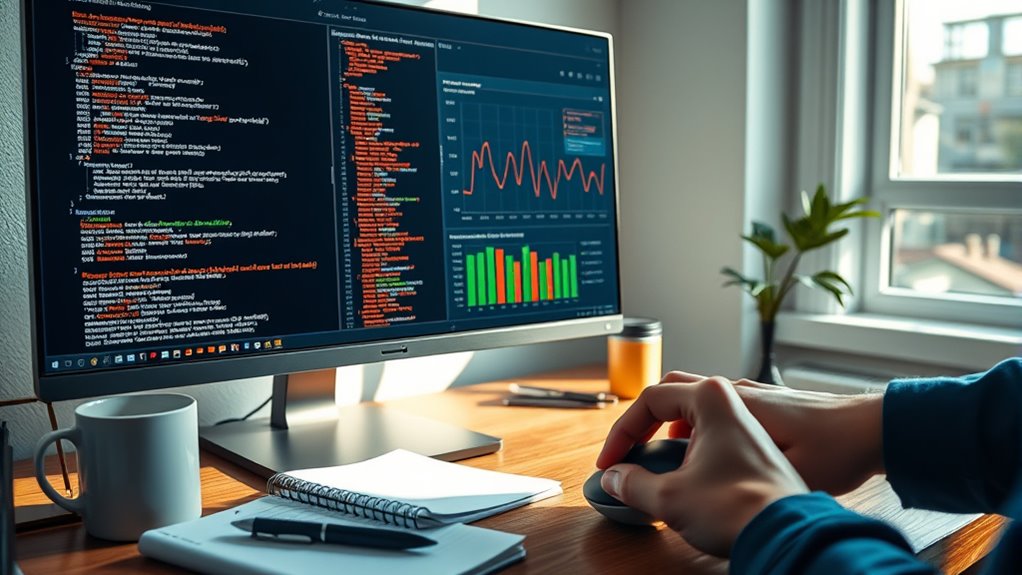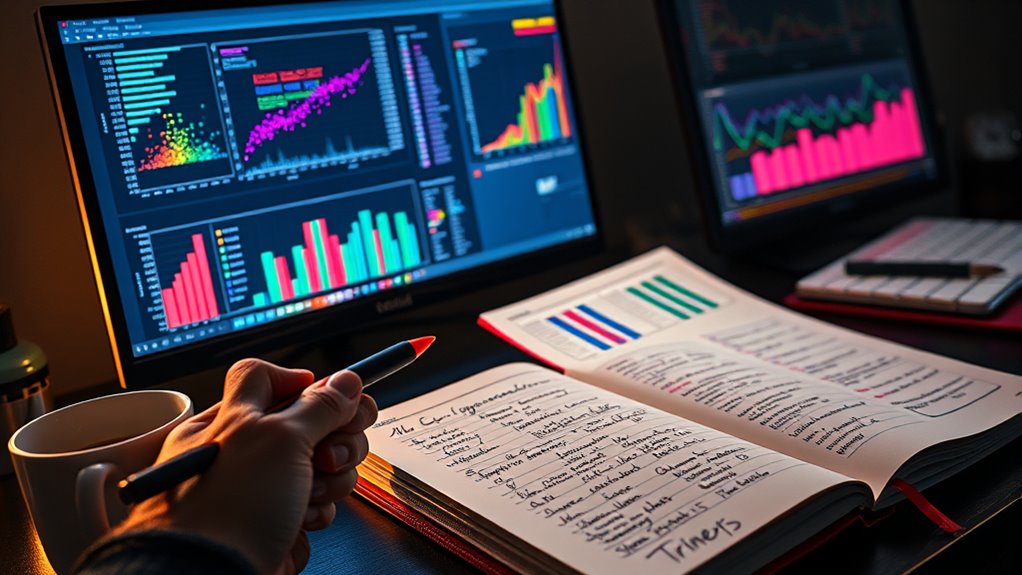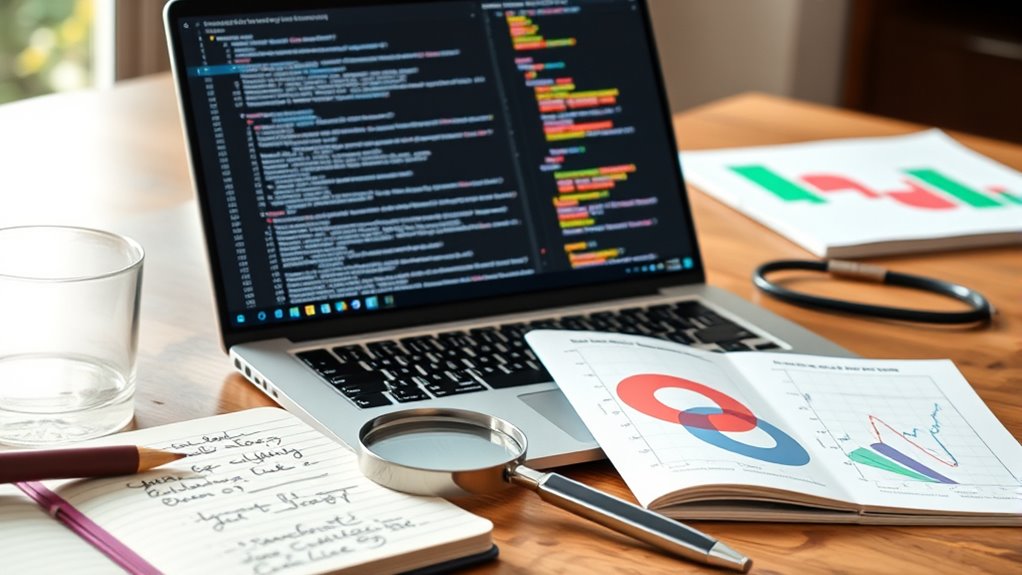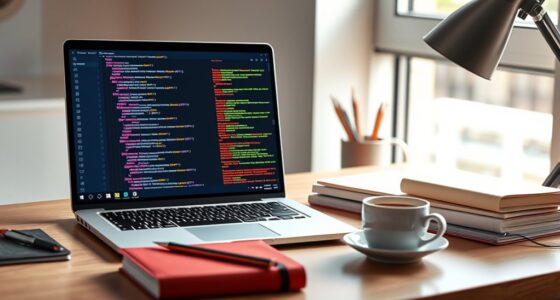To use R for statistical modeling, start by setting up your data and environment—install R and relevant packages like dplyr and ggplot2. Next, build your models with functions like lm() for linear regression or glm() for generalized models. Evaluate their performance using metrics such as R-squared and RMSE, and visualize results with plots. Exploring advanced techniques can improve your models further. Keep exploring, and you’ll discover how to harness the full power of R for data analysis.
Key Takeaways
- Identify your dependent and independent variables, then use `lm()` for simple linear regression models.
- Install and load essential packages like `dplyr`, `tidyr`, and `ggplot2` to facilitate data manipulation and visualization.
- Fit models using formulas such as `model <- y ~ x` and examine outputs for coefficients and p-values.
- Assess model performance with metrics like R-squared, RMSE, and residual plots to ensure validity.
- Explore advanced techniques including GLMs, multi-level models, and machine learning methods for complex data analysis.
Setting Up Your Data and Environment in R

To begin working with data in R, you first need to set up your environment properly. Start by installing R from the official website, choosing the right installer for your operating system.
Getting started with R requires installing R and setting up your environment for smooth data analysis.
For an improved experience, download RStudio, a popular IDE, from its official site.
Next, install essential packages like `dplyr` and `tidyr` using `install.packages()`, which help with data manipulation and tidying.
Check your R version with `R.version` to guarantee compatibility.
Set your working directory with `setwd()` to specify where your data and scripts will reside.
Being aware of breast cancer symptoms can guide the analysis and interpretation of relevant data in your projects.
This setup creates a solid foundation for importing, organizing, and preparing your data for analysis, making a smooth workflow from start to finish.
Building Your First Statistical Model With R

Getting started with your first statistical model in R is straightforward once you understand the basic concepts. First, identify your dependent and independent variables, ensuring your dataset is well-structured. For a simple linear relationship, use the `lm()` function from the `stats` package, specifying your model with a formula like `y ~ x`. This command fits a linear regression model, providing estimates for the intercept and slope. Once fitted, examine the output for coefficients, standard errors, and p-values to interpret the model’s significance. Visualize the relationship with `ggplot2` to verify patterns and residuals. Remember, choosing the right model depends on your data’s nature and the relationship you aim to analyze. It’s also essential to understand the underlying statistical assumptions to ensure your model’s validity. Additionally, understanding how AI bias can affect model outcomes is crucial for accurate analysis. This process sets a solid foundation for more advanced statistical modeling in R.
Evaluating and Improving Model Performance

After fitting your initial model with R, evaluating its performance helps determine how well it captures the underlying data patterns. You can use metrics like R-squared to assess the correlation between observed and predicted values, with higher values indicating a better fit. RMSE provides insight into the model’s accuracy by measuring the average prediction error. Incorporating well-being considerations in model evaluation can also help identify factors that influence outcomes beyond mere statistical measures. Additionally, understanding merchant services risks can inform the selection of appropriate evaluation metrics, especially when dealing with financial data subject to security and compliance concerns.
For logistic regression, Nagelkerke’s, Tjur’s, and Cox & Snell’s R² help evaluate goodness of fit and class discrimination. Tools like the performance and yardstick packages simplify calculating these metrics and generating diagnostic plots.
To improve your model, consider optimization, cross-validation, feature engineering, or hyperparameter tuning. Regularly assess multiple metrics to get a thorough overview, and validate predictions against actual data for better robustness.
Visualizing Data and Model Results for Better Insights

Visualizing data and model results in R transforms complex information into clear, interpretable graphics that enhance your understanding of underlying patterns. With tools like ggplot2 and Plotly, you can create a variety of visualizations, including scatter plots, histograms, and coefficient plots, to interpret your data effectively. Additionally, incorporating interactive visualizations such as those built with Shiny or Plotly allows you to explore models dynamically, zooming in or highlighting specific data points. Diagnostic plots like residual or Q-Q plots help assess model fit, while ROC curves and confusion matrices evaluate classification performance. These visual tools enable you to communicate findings clearly and support better decision-making based on your statistical models. Understanding data visualization techniques can also reveal hidden relationships and trends that might not be obvious from raw data alone.
Exploring Advanced Techniques and Specialized Models

Exploring advanced techniques and specialized models in R enables you to tackle complex data analysis challenges beyond basic methods. You can utilize maximum-likelihood approaches to fit non-linear models and implement Bayesian modeling with packages like rstan for probabilistic analysis. Forsale 100 Non-linear models help analyze intricate relationships, while multi-level models account for nested data structures using functions like lmer(). Data simulation techniques allow testing and validation of your models effectively. Advanced regression methods, such as GLMs and GLMMs, extend traditional models to handle diverse data types, including logistic and Poisson regression. Machine learning techniques like random forests and clustering methods enhance predictive power and data segmentation. Additionally, latent variable models, including factor analysis and SEM, reveal hidden structures in your data, broadening your analytical toolkit. Incorporating model interpretability techniques ensures your complex models remain understandable and actionable, especially when working with high-dimensional data.
Applying R to Real-World Data Analysis Projects

Applying R to real-world data analysis projects involves transforming raw data into meaningful insights through a structured workflow. First, you clean and manipulate data using tools like dplyr and tidyverse, ensuring accuracy. Additionally, understanding data visualization techniques enhances the clarity of your findings. Next, you perform descriptive statistics to understand data distribution, then apply inferential statistics, such as hypothesis testing, to draw broader conclusions. Visualization plays an essential role; with ggplot2 and Shiny, you create compelling graphs and interactive dashboards to interpret results effectively. For predictive insights, you leverage machine learning algorithms like regression, clustering, or neural networks, validating models with cross-validation techniques. Additionally, understanding the market conditions that influence asset performance helps tailor your analysis to real-world scenarios. R’s extensive packages enable applications across finance, healthcare, marketing, and more, making it a versatile tool for tackling diverse real-world problems efficiently.
Frequently Asked Questions
How Do I Choose the Right Statistical Model for My Data?
When choosing the right statistical model, you need to understand your data types and distribution.
Check for assumptions like linearity and normality, and consider model fit criteria such as AIC or BIC.
Use cross-validation to test performance.
Select a model that fits well, meets assumptions, and provides statistically significant results.
Tailor your choice based on your data’s characteristics and the questions you’re aiming to answer.
What Are Common Pitfalls in R Statistical Modeling?
You should watch out for common pitfalls like ignoring data quality, such as typos and missing values, which can skew results. Avoid overfitting by including too many variables or underfitting with too few.
Make sure to validate model assumptions and use proper validation techniques like cross-validation.
Don’t rely solely on p-values or R-squared; consider effect sizes and other metrics to guarantee your model is reliable and interpretable.
How Can I Handle Missing Data Effectively in R?
Did you know that over 30% of datasets have missing data? To handle it effectively, start by identifying missing values with functions like is.na() and summary().
Then, decide whether to remove them using na.omit() or complete.cases(), or impute missing values with methods like mean, median, or advanced packages like mice.
Proper handling guarantees accurate, reliable models.
Which R Packages Are Best for Advanced Statistical Analysis?
You want to know which R packages excel at advanced statistical analysis. You should consider caret for model training and tuning, glmnet for regularized regression, nlme and lme4 for mixed-effects models, and survival for time-to-event data.
These packages provide powerful tools for complex analyses, making them ideal for handling diverse statistical challenges and extracting meaningful insights from your data.
How Do I Interpret Results From Complex Models in R?
You want to interpret results from complex models in R, and it’s all about understanding what the output tells you. Focus on coefficients, their significance, and confidence intervals to grasp predictor effects.
Use diagnostic tools like residual plots and VIF to check assumptions. Summarize findings with tables or plots, and validate your model’s performance with cross-validation.
This approach helps you confidently explain and trust your model’s insights.
Conclusion
Now that you’ve learned how to harness R for statistical modeling, you’re ready to navigate your data with confidence. Think of R as your trusty compass guiding you through complex landscapes, revealing hidden patterns and insights. With practice, you’ll turn raw data into powerful stories, transforming numbers into knowledge. Keep experimenting and exploring—each model you build is a stepping stone toward mastering the art of data analysis. Happy modeling!










